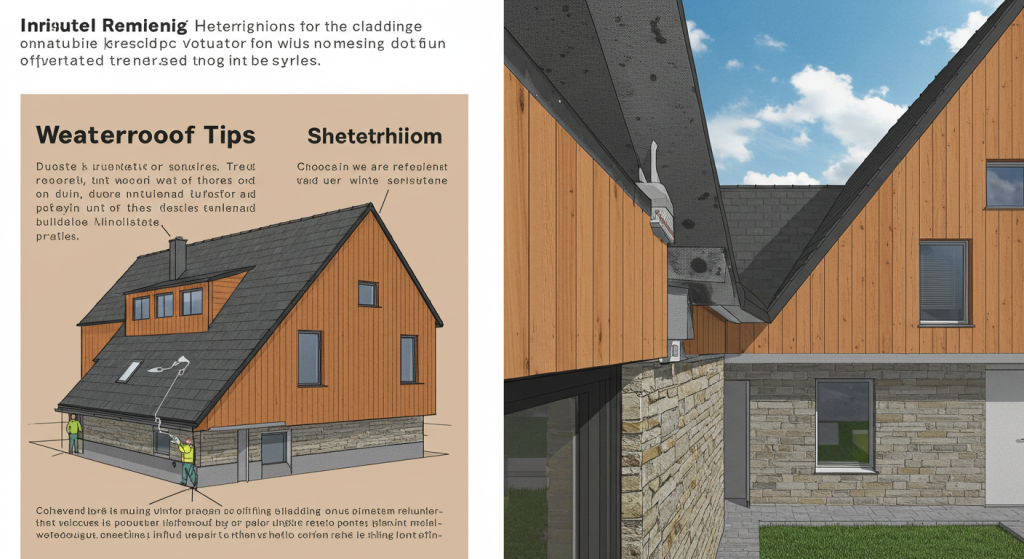Weatherproofing Tips for Exterior Wall Cladding: Top Tips
Everything You Need to Safeguard Your Home
The cladding of the walls on your home’s exterior serves a dual purpose. The aesthetics and curb appeal it adds to your home are beautiful, but more importantly, it also protects your house from strong winds, heavy rain, and any moisture buildup. Regardless of whether your cladding is wood, fiber-cement, bricks, stone, or metal. Keeping such weatherproofing tips for exterior wall cladding is essential in preventing damage structurally and financially later on down the line.
In this article, we will discuss how to properly waterproof weather-resistant barriers and outline a few protective measures while highlighting common mistakes for DIY outfitting that could potentially harm the interior rather than safeguard it.
Why Waterproofing of Wall Weather Claddings is Much More Crucial?
For any building structure exposed to nature’s elements, such as heavy rains, snowfall, along with aggressive temperature changes, harsh winds for long periods without proper shelter, can lead to these consequences:
- Mold is caused by condensing air bubbles due to trapped humid air
- Bubbling systems skin skin-tight surfaces due to expansion from heat
- Under finish materials like Paint bursting used to cover surfaces, shrinking filled up well-spaced volumes
Weatherproofing Requirements By Cladding Type
Different materials require specific approaches. Here we analyze the methods:
Wood Cladding
Wood is an elegant cladding, but moisture can damage it. You may protect wood through:
- Moisture stains or oils
- Allow space behind panels for ventilation
- Quality caulk for joints and edge sealing
- Drip edges to guide water away
This stops water from accessing and infiltrating openings.
Flex: You Should Install a Waterproof Membrane
Treat this as the protective layer under your cladding. Controls moisture infiltration to the structural wall while permitting air circulation and vapor discharge.
Form a Drainage Plane
Within the rain screen, there should be space reserved for the movement of fluid, such as water drainage, as well circulation of air. This becomes critical with rainscreen cladding.
Flashing Done Bril
These flashings placed around windows, doors, and rooflines are very crucial. If placed properly, they will prevent moisture buildup in vulnerable areas by diverting it away from these areas.
Common Problems Stylish Contour—and Their Solutions
Well-designed cladding does not guarantee perfection. Here is what should concern you:
Leaky Walls
Unmaintained and serviced sealants with poor flashing installation results clogged pathways, creating gaps for water ingress. Sealant replacement, coupled with yearly inspections, offers a reliable solution to this issue.
Rotted Timber
Timber suffers a loss of shape due to its ability to absorb liquid materials. Mitigate rot by utilizing preservatives, increased sealing frequency, and rapid replacement of damaged boards.
Cracked Render and Stucco
Small cracks hold the possibility of developing into large concerns over time if left unattended. Early attention tackles big surprises later using proactive filling with special masonry cement sealants on focused low-grade fillers.
Algae & Mold
Waterlogged regions shielded from light attract fungi. ADDRESS: Increase Ventilation; Use breathable membranes; Regular surface cleaning employing eco-friendly methods

DIY Weatherproofing Tips for Homeowners
Are you a DIYer? Weatherproofing tips for exterior wall cladding. If so, take note of the following tips:
- Carefully clean cladding because pressure washers can damage it—apply products after cleaning.
- Flexible outdoor grade sealants must be used to fill all joints and gaps.
- Thick coats of paint or stain are one and done, but multiple thin coats are best applied.
Do not ignore safety precautions—always wear protective gear.
Cladding Maintenance Tips to Extend its Life
Keeping weatherproofing in place is maintained by work done afterwards. Here’s how:
- If moisture can seep through sealants or joints, inspect them twice a year.
- Use low-toxicity biodegradable detergents for cleansing the surfaces.
- Protective finishes should be recoated every two to three years unless recommended otherwise.
- Correct signs such as cracks or moisture leaking/yellowing immediately to prevent bigger issues later on.
Choosing the Right Products for Weatherproofing
Any materials not made specifically for waterproofing will not work as intended correctly due to their purposes not aligning with them, such as membranes and sealants that need:
UV resistance – this prevents degradation under direct sunlight exposure.
Elasticity – the ability to stretch and shrink with weather changes due to temperature shifts.
Breathability – permeates allows moisture vapor to escape.
Compatibility – Seamlessly combines well with your chosen cladding material.
When unsure, experts in building supply outlets are highly recommended, as well as professional builders who offer knowledgeable insights suited to your individual needs.
Conculsion
Your exterior wall cladding requires ongoing weatherproofing maintenance as it provides protection, enhances aesthetic appeal, and cuts down costs. Improving energy efficiency while safeguarding your home gives great value. This guide can help you design an aesthetically pleasing facade out of stone veneer or wood siding that withstands inclement weather year-round.








